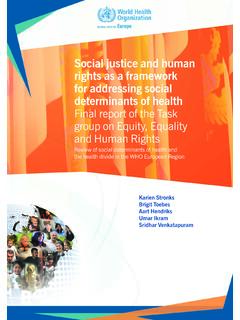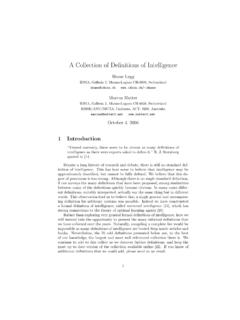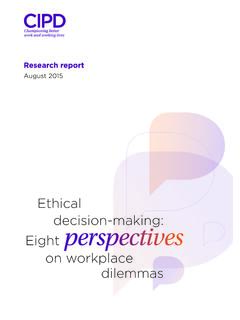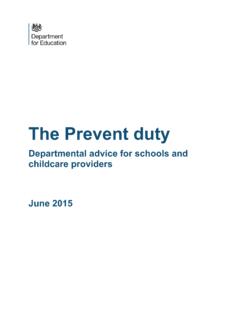Transcription of Guidelines for humane handling, transport and slaughter of ...
1 Guidelines forhumane handling, transport andslaughter of livestockFood and Agriculture Organization of the United NationsRegional Office for Asia and the PacificRAP Publication 2001/4 Guidelines forhumane handling, transport andslaughter of livestockCompiled by:Philip G. ChambersTemple GrandinEdited by:Gunter HeinzThinnarat SrisuvanThe designations employed and the presentation of thematerial in this publication do not imply the expression of anyopinion whatsoever on the part of the Food and AgricultureOrganization of the United Nations concerning the legalstatus of any country, territory, city or area or of itsauthorities, or concerning the delimitation of its frontiers orboundaries.
2 The word countries appearing in the text refersto countries, territories and areas without distinction. Thedesignations developed and developing countries areintended for statistical convenience and do not necessarilyexpress a judgement about the stage reached by a particularcountry or area in the development process. The opinionsexpressed in the articles by contributing authors are notnecessarily those of 1: Animal stress and pain1 CHAPTER 2: Effects of stress and injury on meat and by-product quality3A. Meat quality3 Pale Soft Exudative (PSE) meat3 Dark Firm Dry (DFD) meat4 Spoilage of meat5 Bruising and injury6B.
3 Hides and skins quality8 CHAPTER 3: Marketing systems and losses11 Holding people accountable for losses11 Segmented markets and piecework13 CHAPTER 4: principles of animal behavior15 Relation of animal vision, hearingand smell to stress and injury15 CHAPTER 5: Handling of livestock19 General principles19 Handling in crowd pens and races22 Flight zone and point of balance22 Designs of handling facilities25iiCHAPTER 6: transport of livestock33 Effects of transport33 Methods of transport35 Types of vehicles38 Pre-loading precautions45 transport operations46 CHAPTER 7: slaughter of livestock49 Preparing livestock for slaughter49 Restraint devices49 Stunning methods55 Percussion stunning55 Electrical stunning61 Carbon dioxide gas stunning68 Malpractice in immobilization of livestock68 Religious or ritual slaughter (Halal and Kosher)74 Bleeding76 Determining insensibility at slaughter80 CHAPTER 8.
4 Maintenance of good animal welfare standards83 Five major critical control points83 Objective scoring of efficacy standardsat critical control points84 CONCLUSION91iiiPREFACEMany developing countries have common problemsconcerning animal welfare, particularly in the livestock slaughtersector. These problems include handling of livestock, transport , pre- slaughter penning, stunning and issues of humane treatment of slaughter animals in thesecountries are of growing importance because: In recent decades there has been an increased demandfor livestock products, particularly meats; Meat output in developing countries nowconsiderably exceeds that in developed countries,resulting in increasing numbers of animalsslaughtered.
5 Developing countries with a potential for exportingmeat, where humane treatment of slaughter animals isnot satisfactorily practised, will have to comply withsanitary and welfare requirements of importingcountries; humane treatment of slaughter animals not onlyreduces unnecessary suffering but also reduces loss ofquality and value of meat and animal by-products,thus contributing to food security and income in mostneedy countries; Many developing countries have poorly developedand implemented welfare legislation, resulting inharsh conditions for livestock and excessive budgetary resources, mainly designated to maximiseagricultural production in the food, crop and livestock sectors indeveloping countries, can provide only limited funds for livestockivwelfare.
6 Changes in developing countries towards more humanetreatment of slaughter stock must come about by joint efforts ofgovernments, producers, the meat industry and desirably also withthe help of Non-Government Organizations (NGOs). However,FAO in cooperation with NGOs could be in a position to co-ordinatethese efforts as well as provide technical advice and publication is provided as a joint effort between FAOand the NGO humane Society International (HSI), to offer guidanceto animal welfare personnel, transport operators, farmers andslaughterhouse management etc.
7 In improving slaughter , livestockproductivity and authors are Philip G. Chambers (formerly DeputyDirector of Veterinary Public Health, Department of VeterinaryServices, Bulawayo/Zimbabwe), Temple Grandin (AssistantProfessor, Department of Animal Sciences at Colorado StateUniversity, USA), Gunter Heinz (Animal Production Officer, FAOR egional Office for Asia and the Pacific, Bangkok/Thailand) andThinnarat Srisuvan (Veterinary Officer, Department of LivestockDevelopment, Bangkok/Thailand).Illustrations were contributed by Chambers (Fig.)
8 2, 3, 4,5, 7, 8, 9, 10, 12, 14, 15, 17, 19, 20, 21, 23, 29, 31, 32, 34, 35, 36, 37,38, 43, 45, 47, 49, 53, 55, 56, 58, 59, 60, 61, 73, 74), T. Grandin(Fig. 11, 13), G. Heinz (Fig. 1, 6, 16, 18, 22, 24, 25, 26, 27, 28, 30,33, 39, 40, 41, 42, 44, 46, 48, 50, 52, 54, 57, 62, 63, 64, 65, 66, 67,68, 69, 70, 71, 72, 75, 76, 77) and HSI (Fig. 51).vINTRODUCTIONL ivestock referred to in this manual are animals from whichmeat is produced. Types of food animals vary in different parts ofthe world. This booklet will refer mainly to cattle, goats, sheep,pigs, poultry and ostriches.
9 Other slaughter animals of relevance inparticular in developing countries are buffaloes, camels and transformation of slaughter animals into meat is a chain ofevents including handling and loading on the farm, transport to themarket, pens or slaughterhouse, off-loading and holding and finallyslaughter. During these procedures poor operational techniques andfacilities will lead to unnecessary suffering, injury and loss are many advantages to improving conditions forlivestock destined for slaughter . These will have the benefit ofimprovements in productivity, animal welfare and personnel production through humane treatment of slaughteranimals can be achieved, for example, through: reduced carcass damage and waste and highervalue due to less bruising and injury; decreased mortality; improved quality of meat by reducing animalstress; increased quality and value of hides and animal welfare is necessary to reduce suffering, inline with requirements of Governments, NGOs, and consumers, whoare becoming more concerned with welfare of food animals.
10 Betterconditions of livestock operations will also improve safety ofworkers in the livestock and meat for humane handling, transport and slaughter of livestock1 CHAPTER 1 ANIMAL STRESS AND PAINS cientific research has shown that warm-blooded animals(this includes livestock) feel pain and the emotion of fear. Inparticular mammals, including food animals of this group, have brainstructures that enable them to feel fear and suffering from pain, andit is likely that they suffer pain in the same way as humans. Fear andpain are very strong causes of stress in livestock and stress affectsthe quality of meat obtained from this livestock.















